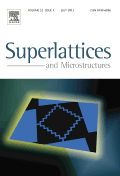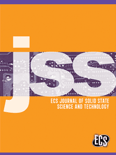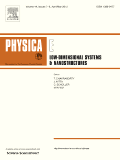
Silicon
Scope & Guideline
Exploring the Future of Electronic Materials
Introduction
Aims and Scopes
- Silicon-Based Materials for Electronics:
Research related to the synthesis, characterization, and application of silicon in various electronic devices, including transistors, sensors, and solar cells. - Nanotechnology and Silicon Nanostructures:
Exploration of silicon nanostructures such as nanowires, nanoparticles, and their applications in photonics, electronics, and catalysis. - Silicon in Agriculture:
Studies examining the role of silicon in enhancing plant growth, stress resistance, and nutrient uptake, contributing to sustainable agriculture. - Silicon Recycling and Waste Management:
Innovative methods for recycling silicon and utilizing silicon waste products in various industrial applications. - Silicon-Based Composites:
Development and analysis of silicon-based composites for various applications, including construction materials, coatings, and biomedical devices. - Theoretical and Computational Studies:
Application of theoretical models and computational techniques to understand the behavior of silicon and silicon compounds at the atomic and molecular levels.
Trending and Emerging
- Advanced Silicon Nanostructures:
There is a growing emphasis on the development and application of silicon nanostructures, including nanowires and nanoparticles, for use in high-performance electronic and optoelectronic devices. - Silicon in Sustainable Agriculture:
Research focusing on silicon's role in enhancing crop resilience, nutrient uptake, and overall agricultural productivity is increasingly prevalent, indicating a trend towards sustainable agricultural practices. - Biocompatible Silicon Materials:
The exploration of silicon-based materials for biomedical applications, including drug delivery systems and tissue engineering, is on the rise, reflecting an interdisciplinary approach to silicon research. - Silicon Recycling Technologies:
Innovations in recycling silicon from electronic waste and other sources are becoming a focal point, aligning with global sustainability goals and resource recovery initiatives. - Integration of Machine Learning with Silicon Research:
The incorporation of machine learning techniques to optimize silicon-related processes and predict material behaviors is emerging as a significant trend in the field.
Declining or Waning
- Traditional Silicon Electronics without Novel Approaches:
As the field advances, there is a noticeable decrease in papers solely focused on conventional silicon technologies without innovative modifications or enhancements. - Basic Silicon Chemistry:
Research that emphasizes only the fundamental chemical properties of silicon, lacking practical applications, is becoming less prevalent. - Silicon in Non-Agricultural Applications:
The emphasis on silicon's role in agriculture and its benefits is overshadowing traditional studies that do not connect silicon to agricultural practices or sustainability. - Silicon in Environmental Remediation:
While environmental applications are still relevant, the specific focus on silicon's role in remediation processes is diminishing as more integrated approaches gain traction.
Similar Journals

SUPERLATTICES AND MICROSTRUCTURES
Elevating knowledge in the fields of physics and engineering.SUPERLATTICES AND MICROSTRUCTURES is a premier journal dedicated to the exploration and dissemination of cutting-edge research in the fields of Condensed Matter Physics, Electrical and Electronic Engineering, and Materials Science. Published by Academic Press Ltd - Elsevier Science Ltd, this journal has established itself as an important platform for scholars and industry professionals to share their findings related to the design, fabrication, and application of superlattices and microstructured materials. With a commendable impact factor reflected in its rankings—positioned within the top quartile in Physics and Astronomy as well as Electrical and Electronic Engineering—it offers high visibility and influence in the academic community. The journal has covered significant contributions from 1985 to 2022, although access options have transitioned, making staying current essential for researchers and practitioners alike. This journal not only serves as a repository of knowledge but also fosters collaboration and innovation in materials science and related disciplines.

ECS Journal of Solid State Science and Technology
Catalyzing Breakthroughs in Solid State TechnologiesECS Journal of Solid State Science and Technology, published by the Electrochemical Society, is a prominent journal dedicated to the advancement of research in the field of electronic, optical, and magnetic materials. With an ISSN of 2162-8769 and an E-ISSN of 2162-8777, this journal has established a significant presence since its inception in 2012, spanning critical developments in solid-state science that are essential for innovative technologies. Operating within the United States and recognized for its global outreach, it holds a respectable Q3 category ranking in the materials science category as of 2023, reflecting its commitment to high-quality research and its role in bridging theoretical and applied aspects of materials science. Researchers, professionals, and students alike will find vital information and cutting-edge studies that further the understanding and applications of solid-state technologies. The journal is accessible to an extensive audience, making it an invaluable resource for those engaged in the ever-evolving landscape of materials science.

Elastomers and Composites
Shaping Tomorrow's Materials Through Rigorous ScholarshipElastomers and Composites is a leading academic journal dedicated to the advancement of knowledge in the fields of polymer science and materials engineering, specifically focusing on elastomers and composite materials. Published by RUBBER SOC KOREA, this journal serves as a vital platform for researchers and professionals to disseminate innovative research findings and insights in material properties, applications, and synthesis techniques. Although it currently does not offer open access, the journal provides rigorous peer-reviewed content that enhances the global dialogue on elastomeric materials and their composites, reflecting its commitment to high-quality scholarship. With a strong emphasis on practical relevance and theoretical advancements, Elastomers and Composites aspires to reshape industry practices and academic thought, making it an invaluable resource for students, researchers, and practitioners alike. Positioned strategically within its field, this journal fosters collaboration and dialogue among scientific communities, all while supporting the growth of cutting-edge research programs worldwide.

JOURNAL OF MATERIALS SCIENCE-MATERIALS IN ELECTRONICS
Driving Progress in Electronic Materials ResearchJOURNAL OF MATERIALS SCIENCE-MATERIALS IN ELECTRONICS, published by Springer, is a distinguished international journal that serves as a vital platform for the dissemination of cutting-edge research in the field of materials science, with a keen focus on electronics. Since its inception in 1990, this journal has consistently contributed to the advancement of knowledge across a range of interdisciplinary categories, including Atomic and Molecular Physics, Optical and Magnetic Materials, and Biomedical Engineering, achieving notable quartile positions in various 2023 Scopus rankings. With an impact factor that signifies its scholarly influence, this journal provides a rigorous peer-reviewed environment for researchers and practitioners to share innovative ideas, experimental findings, and theoretical developments. Although it does not currently offer open access options, the depth and breadth of topics covered—including condensed matter physics and bioengineering—make it an essential resource for those at the forefront of materials research. With a commitment to bridging the gap between theory and practical application, the JOURNAL OF MATERIALS SCIENCE-MATERIALS IN ELECTRONICS continues to pave the way for future explorations in the ever-evolving landscape of materials science.

SEMICONDUCTORS
Pioneering insights in condensed matter physics.SEMICONDUCTORS, published by PLEIADES PUBLISHING INC, is a prominent journal that provides a platform for researchers and professionals in the fields of Atomic and Molecular Physics, Condensed Matter Physics, and Electronic, Optical and Magnetic Materials. With an ISSN of 1063-7826 and an E-ISSN of 1090-6479, the journal has been diligently disseminating knowledge since its inception in 1996 and continues to pave the way for innovative research until 2024. Although currently unclassified in the Open Access model, its influence is underscored by its rankings in Scopus, where it ranks in the 21st-22nd percentile across critical scientific categories. SEMICONDUCTORS serves as an essential resource for cutting-edge research, fostering a greater understanding of semiconductor materials and their applications, thereby assisting the scientific community in pushing the boundaries of technology and innovation.

Journal of Nanostructures
Shaping the Future with Nanostructured InsightsJournal of Nanostructures, published by UNIV KASHAN PRESS, is an esteemed open-access journal that has been actively disseminating groundbreaking research since 2011. With an ISSN of 2251-7871 and an E-ISSN of 2251-788X, this journal has established itself as a significant platform for the exploration of nanostructured materials across various disciplines, including biomaterials, electronic, optical, and magnetic materials. As a testament to its scholarly impact, the journal has achieved notable rankings in its respective categories, including Q3 status in prominent areas such as Mechanics of Materials and Polymers and Plastics. This makes the Journal of Nanostructures a vital resource for researchers and professionals seeking to advance their understanding and innovation in nanotechnology. Furthermore, the journal's commitment to open accessibility ensures that valuable knowledge reaches a diverse audience, facilitating collaboration and growth in this dynamic field. For researchers eager to contribute, the journal offers a platform to publish impactful findings that can influence both academia and industry.

Journal of the Korean Ceramic Society
Connecting researchers to shape the future of materials science.The Journal of the Korean Ceramic Society is a premier academic journal dedicated to advancing the field of ceramics and composites, serving as a vital platform for researchers, professionals, and students alike. Published by SPRINGER HEIDELBERG, this journal boasts an impressive scopus rank of #49 out of 127 in the Materials Science category, with a commendable 61st percentile ranking, highlighting its impact and relevance in contemporary research. Since its inception, the journal has been converging significant research contributions from 2007 to 2024, consistently fostering innovation in ceramic materials and their diverse applications. Although it operates under a traditional access model, the journal remains committed to disseminating high-quality research in ceramics and composites, currently positioned in the Q2 category for 2023. With a strategic focus on the latest developments, methodologies, and interdisciplinary approaches, the Journal of the Korean Ceramic Society is essential reading for anyone engaged in materials science and engineering, aiming to navigate the complexities of this dynamic field.

Journal of Optical Microsystems
Illuminating Research in Optical and Electronic MaterialsJournal of Optical Microsystems, published by SPIE-SOC PHOTO-OPTICAL INSTRUMENTATION ENGINEERS, is a premier open-access journal dedicated to advancing the field of optical microsystems. With a focus on the intersections of Atomic and Molecular Physics, Electrical Engineering, and Materials Science, this journal has quickly emerged as a key resource since its inception in 2021, currently maintaining a Q2 ranking in multiple relevant categories. Although it is relatively new, its impact within the academic community is reflected in its percentile rankings, positioning it among the top-tier journals. The Journal provides a platform for researchers, professionals, and students to publish and access cutting-edge studies that explore innovative applications of optical technologies. With its commitment to disseminating high-quality research and the growing importance of optics in technology, the Journal of Optical Microsystems plays a critical role in bridging the gap between theoretical advancements and practical applications in the field. Located in the United States, it is poised to connect an international audience eager to contribute to and benefit from developments in optical and electronic materials.

PHYSICA E-LOW-DIMENSIONAL SYSTEMS & NANOSTRUCTURES
Illuminating the pathways of electronic, optical, and magnetic materials.PHYSICA E-LOW-DIMENSIONAL SYSTEMS & NANOSTRUCTURES, published by ELSEVIER, is a premier journal dedicated to advancing the field of condensed matter and nanoscience, focusing on the innovative properties and applications of low-dimensional systems. With an esteemed Q2 ranking in multiple categories including Atomic and Molecular Physics, Condensed Matter Physics, and Nanoscience for 2023, this journal serves as a vital platform for researchers and professionals aiming to disseminate and discuss cutting-edge research. Established in 1974 and converging its focus from 1997 onwards, PHYSICA E captures the evolving landscape of material science, making it a crucial resource for anyone invested in the dynamics of electronic, optical, and magnetic materials. Although the journal operates on a subscription basis, its broad accessibility and significant placement within Scopus rankings—such as being in the 83rd percentile for Condensed Matter Physics—underscore its importance within the academic community. Researchers and students alike will find this journal a cornerstone for fostering knowledge and collaboration in the fields of nanotechnology and low-dimensional physics.

RIVISTA DEL NUOVO CIMENTO
Connecting Scholars through High-Impact Scientific Discoveries.RIVISTA DEL NUOVO CIMENTO, published by SPRINGERNATURE, is a prestigious journal dedicated to advancing research in the field of physics and astronomy. Established in 1969, this journal has consistently delivered high-quality, peer-reviewed articles that explore emerging topics and significant developments in the broad scope of general physics. With an impressive Q1 ranking in the 2023 category for Physics and Astronomy and a remarkable Rank #23/243 in Scopus, it is recognized as a leading resource, standing in the 90th percentile of its field. Although not an open-access journal, RIVISTA DEL NUOVO CIMENTO ensures wide dissemination of its impactful content, making it essential reading for researchers, professionals, and students who are eager to stay ahead in their academic pursuits. Join a vibrant community dedicated to excellence and innovation in physics and astronomy by exploring the cutting-edge works published in this esteemed journal.